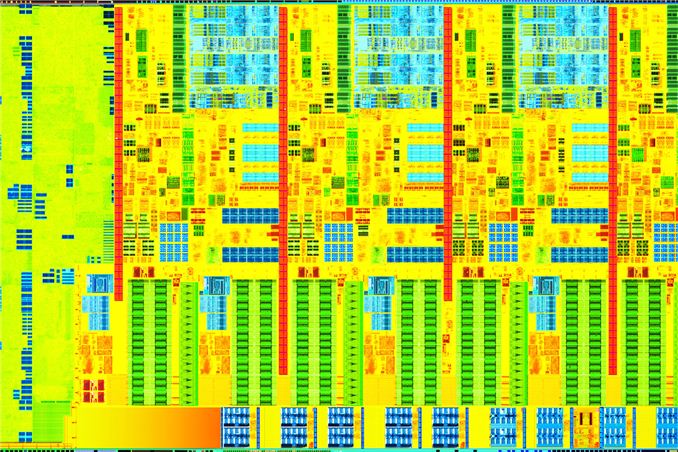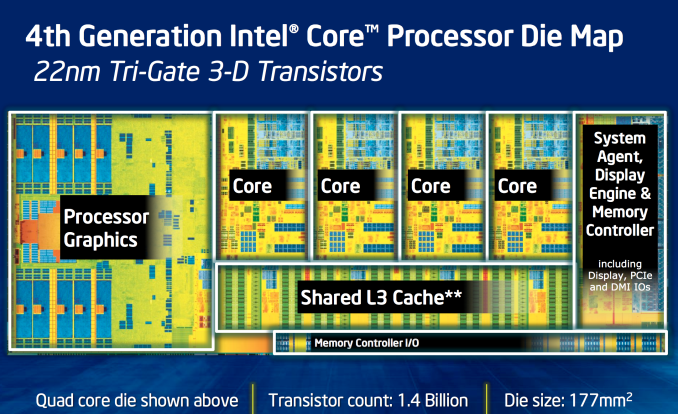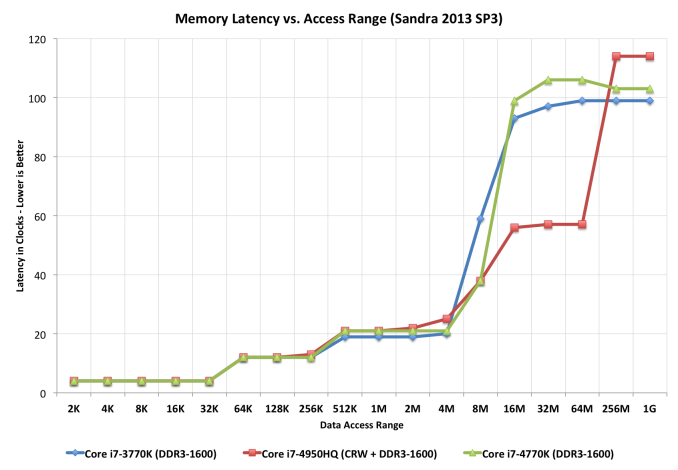The Haswell Review: Intel Core i7-4770K & i5-4670K Tested
by Anand Lal Shimpi on June 1, 2013 10:00 AM EST
This is a very volatile time for Intel. In an ARM-less vacuum, Intel’s Haswell architecture would likely be the most amazing thing to happen to the tech industry in years. In mobile Haswell is slated to bring about the single largest improvement in battery life in Intel history. In graphics, Haswell completely redefines the expectations for processor graphics. There are even some versions that come with an on-package 128MB L4 cache. And on the desktop, Haswell is the epitome of polish and evolution of the Core microprocessor architecture. Everything is better, faster and more efficient.
There’s very little to complain about with Haswell. Sure, the days of insane overclocks without touching voltage knobs are long gone. With any mobile-first, power optimized architecture, any excess frequency at default voltages is viewed as wasted power. So Haswell won’t overclock any better than Ivy Bridge, at least without exotic cooling.
You could also complain that, for a tock, the CPU performance gains aren’t large enough. Intel promised 5 - 15% gains over Ivy Bridge at the same frequencies, and most of my tests agree with that. It’s still forward progress, without substantial increases in power consumption, but it’s not revolutionary. We compare the rest of the industry to Intel’s excellent single threaded performance and generally come away disappointed. The downside to being on the top is that virtually all improvements appear incremental.
The fact of the matter is that the most exciting implementations of Haswell exist outside of the desktop parts. Big gains in battery life, power consumption and even a broadening of the types of form factors the Core family of processors will fit into all apply elsewhere. Over the coming weeks and months we’ll be seeing lots of that, but today, at least in this article, the focus is on the desktop.
Haswell CPU Architecture Recap
Haswell is Intel’s second 22nm microprocessor architecture, a tock in Intel’s nomenclature. I went through a deep dive on Haswell’s Architecture late last year after IDF, but I’ll offer a brief summary here.
At the front end of the pipeline, Haswell improved branch prediction. It’s the execution engine where Intel spent most of its time however. Intel significantly increased the sizes of buffers and datastructures within the CPU core. The out-of-order window grew, to feed an even more parallel set of execution resources.
Intel added two new execution ports (8 vs 6), a first since the introduction of the Core microarchitecture back in 2006.
On the ISA side, Intel added support for AVX2, which includes an FMA operation that considerably increases FP throughput of the machine. With a doubling of peak FP throughput, Intel doubled L1 cache bandwidth to feed the beast. Intel also added support for transactional memory instructions (TSX) on some Haswell SKUs.
The L3 cache is now back on its own power/frequency plane, although most of the time it seems to run in lockstep with the CPU cores. There appears to be a 2 - 3 cycle access penalty as a result of decoupling the L3 cache.


















210 Comments
View All Comments
random2 - Monday, June 3, 2013 - link
Other reviewers are getting the more standard 10-15% difference on average across the board typically seen with Intel and a new gen. introduction over their previous gen. If it's not being seen here, maybe there are benches not included that should be.Achaios - Tuesday, June 4, 2013 - link
1.72 FPS difference between an i7-2600k and an i7-4770k. This is so hopelessly pathetic.My QX9650 and my Asus P5Q Deluxe just got a 2 year life extension. I wonder when it's going to be worth it to finally ditch my 2008 system!!!
Arbie - Wednesday, June 12, 2013 - link
The CPU does not control the FPS you're talking about. Beyond a certain point of CPU power (long ago passed) FPS depends on the external graphics card. A Haswell i7-4770K CPU will, according to the Anandtech benchmarks, be about twice as powerful as your QX9650. At 1/3 the cost, and far less idle power. That's not "pathetic".You may very well not want to upgrade, because you won't see a difference in your games - but that isn't Intel's fault. In fact it's a problem for them and the desktop market in general. Gains in CPU power are becoming irrelevant. As are PC games, BTW, which is why graphics cards are improving so slowly now. In two more years... it will be the same story, except more so.
monohouse - Sunday, June 23, 2013 - link
+1, I upgraded my system:from a E6750 (3800 Mhz, 4MB) to E8400 (4300 Mhz, 6MB)
from GTX 480 (840 Mhz, 1.5 GB) to GTX 580 (930 Mhz, 3 GB)
and got the same FPS in crysis 2 (with MaLDo HD + hi-res textures + DX11)
shows that in some cases, there is no improvement
Gastoncapo - Wednesday, June 5, 2013 - link
honestly, i'm still running my 2500k @5ghz ...i don't see the point in upgrading yet, guess i'll just switch my 580 gtx for a 780 :DNillerboy - Sunday, June 9, 2013 - link
will there be made a review of Intel 4770S?I am considering making a lab with this cpu, and would like to see proformence difference between the Intel 4770 and 4770S.
C433 - Wednesday, June 12, 2013 - link
second this, best would be to also include 4670S and at least one of the T modelsThomasS31 - Monday, June 10, 2013 - link
Anand,What is intels response to the overheating/throttling issues with stock cooler haswell (not OC).
Can you investigate this issue more (as you can as ususal).
Seems there are some manufacturing quality issues with the heat spreader and thermal paste.
Arbie - Wednesday, June 12, 2013 - link
Just some info for others considering a Haswell desktop build.I have just assembled an i5-4670K on an Asus Gryphon Z87 mATX mobo, with 8GB of Corsair Vengenace RAM (1333MHz) and a GTX 650ti graphics board. This is with a 250GB Samsung SSD and a old 500GB mechanical drive. The PSU is a Corsair CX600 80-Plus.
==> At stock clocks, idling on the Windows desktop, this PC pulls only 39W from the wall!
I am amazed. Idle power is important to me since the box is in a poorly-ventilated room. Upping the AC to improve that area would freeze the rest of the house AND cost a bundle. The time periods spent at full load are negligible in comparison. But the performance is there when needed... this CPU is nearly twice as powerful as my Yorkfield build, which idles at 170W, with HD 5770 gfx and an SSD.
So I'm very pleased with Haswell on the desktop. And yes, I could have bought a lower level chip and mobo for this use, saving money and a few more Watts, but I wanted the good stuff and the PC may someday be moved to where an OC would be practical.
emperius - Friday, June 14, 2013 - link
Well I certainly can wait for AMD to truly boost their competition from Sony and Microsoft's budget here. Let's face it, multi-year contract for console apu's should economically boost them massively.